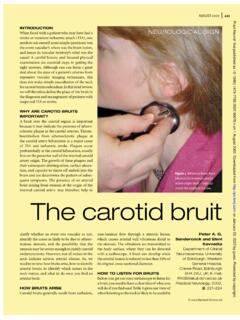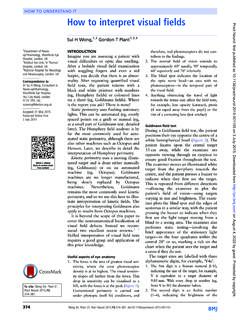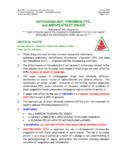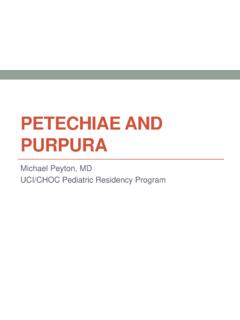Transcription of Periprocedural antithrombotic management for lumbar ...
1 Review Periprocedural antithrombotic Pract Neurol: first published as on 28 August 2018. Downloaded from on February 7, 2022 by guest. Protected by copyright. management for lumbar puncture: Association of British Neurologists clinical guideline Katherine Claire Dodd,1,2 Hedley C A Emsley,1,3. Michael J R Desborough,4,5 Suresh K Chhetri1,6. Additional material is Abstract questionnaire relating to these guidelines published online only. To view, lumbar puncture (LP) is an important and has been completed and is available as an please visit the journal online (http:// dx. rg/ 10. 1136/ frequently performed invasive procedure for inline supplementary appendix (Supple- practneurol- 2017- 001820). the diagnosis and management of neurological mentary file 1).
2 1. 1. conditions. There is little in the neurological Department of Neurology, literature on the topic of Periprocedural Current guidance Royal Preston Hospital, Lancashire Teaching Hospitals management of antithrombotics in patients Current guidance on the Periprocedural NHS Foundation Trust, Preston, undergoing LP. Current practice is therefore UK. management of antithrombotics for 2. largely extrapolated from guidelines produced spinal procedures has mainly come from Department of Neurology, Greater Manchester by anaesthetic bodies on neuraxial anaesthesia, anaesthetic groups regarding neuraxial Neuroscience Centre, Salford, haematology groups advising on Periprocedural 4 The most recent guidelines Greater Manchester, UK management of antiplatelet agents and 3.
3 Lancaster Medical School, were published by the European Society anticoagulants, and by neuroradiology on of Anaesthesiology (ESA),4 and the Amer- Lancaster University, Lancaster, UK imaging-guided spinal procedures. This paper ican Society of Regional Anesthesia and 4. Department of Haematology, summarises the existing literature on the Pain Medicine (ASRA).3 In the UK, there Churchill Hospital, Oxford, UK topic and offers recommendations to guide 5. Radcliffe Department of is joint guidance from the Association of Periprocedural antithrombotic management Anaesthetists of Great Britain and Ireland, Medicine, University of Oxford, Oxford, UK for LP, based on the consolidation of the best the Obstetric Anaesthetists' Association 6. University of Central available evidence.
4 And Regional Anaesthesia Only two Lancashire, Preston, UK. guidance articles specifically relate to LP. Correspondence to and antithrombotics: one in the Amer- Dr Katherine Claire Dodd, ican Journal of Neuroradiology regarding Department of Neurology, Introduction Greater Manchester lumbar puncture (LP) is commonly used image-guided spinal procedures,6 and Neuroscience Centre, Stott Lane, in neurology practice for diagnostic and a recent review article in a Brazilian Salford, Greater Manchester M6. therapeutic indications. In the context of 8HD ; k atywhiteway@ doctors. There is guidance on perioperative org. uk an ageing population, increasing numbers of patients are prescribed regular anti- management of anticoagulants and anti- Accepted 18 July 2018 platelet or anticoagulant medication platelets recently released by the British (collectively known as antithrombotics), Society of Haematology (BSH), and also and/or have comorbid coagulopathies previously from the American College of including thrombocytopenia, platelet Chest 9 The BSH guideline dysfunction and coagulation factor defi- expands on the 2011 guidance on the ciencies.
5 Herein, we present a review of general management of The Author(s) (or their existing literature relating to periproce- BSH and National Institute for Health employer(s)) 2018. No and Care Excellence provide guidelines commercial re-use. See rights dural management of antithrombotics and permissions. Published in patients undergoing LP and draw on preoperative coagulation 12. by BMJ. recommendations from these for use in To cite: Dodd KC, clinical practice, as well as highlighting Risk versus benefit Emsley HCA, Desborough MJR, other factors that should be considered LP carries a risk of spinal haematoma et al. Pract Neurol Epub ahead of print: [please include Day when assessing a patient's bleeding risk. and, rarely, intracranial 14. Month Year]. We have also created an easy-to-follow The incidence of spinal haematoma practneurol-2017-001820 visual summary (figure1).
6 An AGREE following LP has not been reliably Dodd KC, et al. Pract Neurol 2018;0:1 11. 1. Review estimated, but following epidural or spinal anaes- Coagulopathies Pract Neurol: first published as on 28 August 2018. Downloaded from on February 7, 2022 by guest. Protected by copyright. thesia the reported incidence ranges from 1:1341 Thrombocytopenia to 1:200 15 16 A recent review identified 35 Guidance from the BSH suggests that a safe' platelet cases of spinal haematoma following LP since 1974; count for performing LP would be >40 109/L, and this study found a significant correlation between that those with a platelet count of 20 40 109/L be pre-existing coagulopathy and poor neurological evaluated on an individual basis regarding the poten- outcome (significant impairment, inability to ambu- tial risk:benefit These recommendations do late without support and/or bowel/bladder dysfunc- not take account of additional risk factors such as anti- tion).
7 13 The risk of haemorrhagic complications thrombotics, other coagulopathies, platelet dysfunc- during spinal procedures rises with coagulopathy, tion or situations in which the platelet count may fall increasing age, larger needle gauge, multiple needle rapidly between blood measurement and procedure. insertions, existing vertebral column pathology, If an LP is required in an emergency in a patient with epidural rather than spinal anaesthetic and lumbar thrombocytopenia, or if the platelet count is not rather than thoracic 4 16 17 expected to recover independently within an accept- The potential benefits of an LP must be weighed able time period, then a platelet transfusion could against the risk of bleeding. Even a small volume be considered in selected patients; however, there is haematoma can potentially cause significant morbidity, limited evidence to guide this,22 so discussion with the local haematology team is advised.
8 Unlike small volume bleeding at other anatomical sites. In addition, although the risk of spinal haematoma is low, it has an associated a large morbidity; in the case Routine coagulation testing series of 35 patients, 43% were left with significant Multiple guidelines concur that routine, unselected, disability, and 23% died within 12 If the coagulation testing is not required in those with a procedure is deemed necessary but there remains a negative bleeding history and no liver 11 12. 23. high risk of bleeding, repeat traumatic attempts should coagulation tests can be considered for patients be avoided, and one could consider using fluoroscopic with a history of bleeding, anticoagulant drugs, liver guidance to reduce the risk of accidental injury to small or renal failure, disseminated intravascular coagu - blood Spinal haematoma should be suspected lation, haematological disorders or inherited causes in anyone post-LP who develops progressive motor or of Note that coagulation test results sensory disturbance, and/or sphincter disturbance; it do not correlate well with the risk of bleeding, and is frequently painless, and most present several days their utility is uncertain.
9 We recommend discussion after the procedure, with complete paralysis then with a haematologist if the patient is considered at developing over 10 15 19 All suspected cases increased risk of bleeding for any reason, if there is a should be promptly investigated with MRI,20 as the significant bleeding history, or if (should these tests are more rapidly any necessary neurosurgical intervention performed) an international normalised ratio (INR) or occurs, the better the 21 Complete neuro- prothrombin time (PT) ratio is or more, or the acti- logical recovery is unlikely if neurosurgical inter- vated partial thromboplastin time (APTT) is prolonged vention does not occur within 8 hours of symptom above the reference range. Patients should be advised to seek emergency medical attention if they develop new neurological Inherited bleeding disorders symptoms following LP.
10 management of patients with known inherited Suspending antithrombotics also carries risk; usually bleeding disorders including Von Willebrand disease, of cardiac or cerebral ischaemia, or of venous throm- haemophilia, inherited factor deficiencies and inher- boembolism. Therefore, the potential benefits of ited platelet function disorders should be discussed performing an LP must be weighed against the risk of with a haematologist for advice on specific manage- temporary suspension of antithrombotic treatment. ment. Similarly, discussion is needed for patients with High-risk patients should have appropriate bridging a personal or family history of unexplained bleeding treatment, discussed in more detail below; however, who have not previously been investigated.









